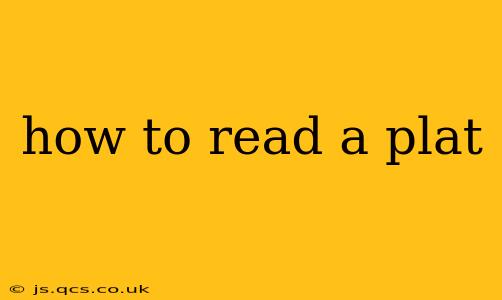A plat is a detailed map or survey showing the divisions of a piece of land, typically into lots for sale or development. Understanding how to read a plat is crucial for anyone involved in real estate, construction, or land surveying. This guide will walk you through the essential elements of a plat and how to interpret them.
What Information is Contained on a Plat?
A plat typically includes the following information:
- Legal Description: This precisely defines the boundaries of the entire surveyed area. It's often a complex combination of metes and bounds, or government lot and block descriptions.
- Lot and Block Numbers: Each individual parcel of land is assigned a unique lot and block number. This is essential for identifying specific properties.
- Dimensions and Bearings: The plat shows the dimensions (length and width) of each lot and the bearings (compass directions) of its boundaries. This information is crucial for determining the precise size and location of each property.
- Streets and Roads: The plat depicts the layout of streets, roads, and other public rights-of-way within the surveyed area.
- Easements: Easements, which are rights granted to others to use a portion of the property (e.g., for utilities), are often clearly marked on the plat.
- Setbacks: Setback lines indicate the minimum distance a building can be placed from property lines. These are important for compliance with local building codes.
- Monuments: These are physical markers (e.g., iron pins, concrete markers) used to define property boundaries. Their locations are usually indicated on the plat.
- Scale: The scale indicates the ratio between the distances on the plat and the actual distances on the ground. This allows you to accurately measure distances on the plat.
- North Arrow: This indicates the direction of true north. Understanding the orientation is critical for interpreting bearings and distances.
- Legend: The legend explains the symbols and abbreviations used on the plat. This is essential for understanding the various features depicted.
How to Interpret the Information on a Plat
Reading a plat requires careful attention to detail and an understanding of basic surveying principles. Here's a step-by-step approach:
1. Identify the Key Elements
Begin by locating the legal description, lot and block numbers, scale, and north arrow. This provides a foundation for understanding the rest of the plat.
2. Understand the Bearings and Distances
Pay close attention to the bearings and distances indicated for each lot line. These numbers, along with the scale, allow you to determine the precise dimensions and location of each property.
3. Locate the Easements and Setbacks
Look for any easements or setbacks indicated on the plat. These are vital pieces of information that can affect the use and development of the property.
4. Examine the Monuments
If monuments are indicated, note their location. These markers are key references for determining property boundaries.
5. Use the Legend
Refer to the legend to understand any symbols or abbreviations used on the plat. This will help you accurately interpret all features depicted.
What if I Don't Understand a Specific Part of the Plat?
If you encounter any part of the plat that you don't understand, it's best to consult with a qualified surveyor or real estate professional. They can provide expert interpretation and guidance.
Frequently Asked Questions (FAQs)
What is the difference between a plat and a survey?
While related, a plat is a simplified map showing land divisions, while a survey is a more detailed and precise measurement of the land's boundaries. A survey is often used to create a plat.
Where can I find a plat for a property?
Plats are typically recorded with the county recorder or assessor's office in the county where the property is located.
Are all plats created equally?
No, the level of detail and accuracy can vary depending on the age of the plat, the surveyor's expertise, and local regulations. Older plats might lack some information found in modern plats.
Can I use a plat to determine property lines?
While a plat is a helpful tool, it shouldn't be solely relied upon for determining exact property lines. A professional land survey is recommended for that purpose.
What happens if there are discrepancies on a plat?
Discrepancies on a plat can lead to boundary disputes. It’s crucial to resolve these issues through a professional land survey and legal counsel if necessary.
By following these guidelines and understanding the essential components of a plat, you can gain valuable insights into land ownership and property boundaries. Remember, when in doubt, consult a professional for accurate interpretation.
